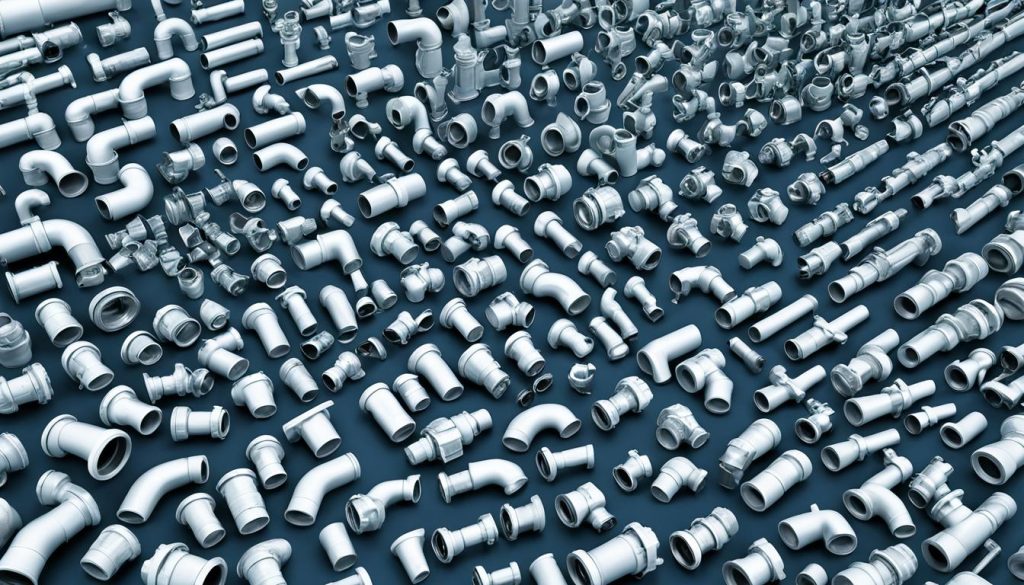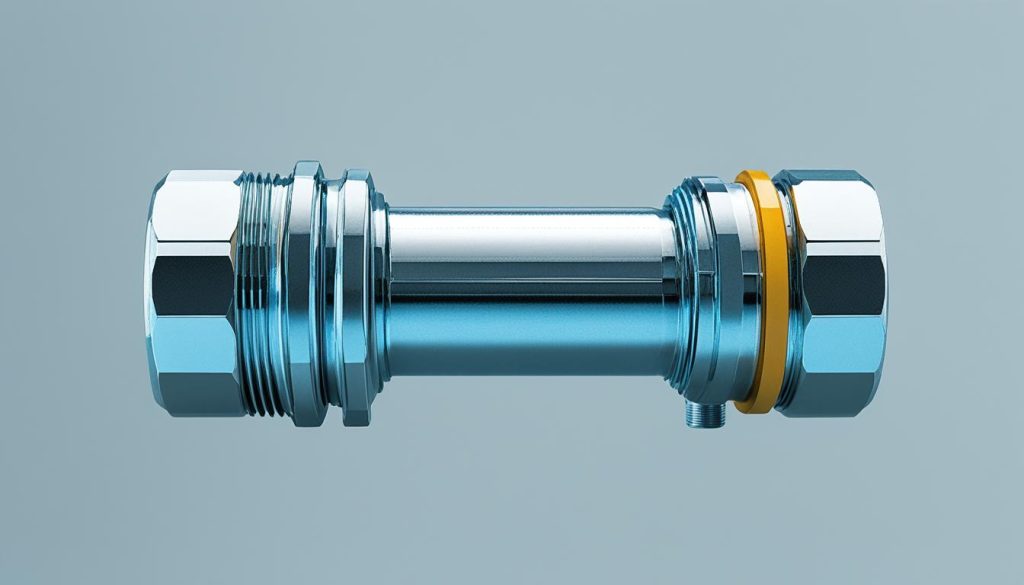Essential Piping and Plumbing Fitting Guide
Did you know that a single faucet leak can waste up to 3,000 gallons (11,356 liters) of water per year? That’s enough water to fill an Olympic-sized swimming pool! When it comes to plumbing projects, choosing the right piping and plumbing fittings is crucial to prevent wastage, ensure efficiency, and maintain a reliable plumbing system. With the wide variety of fittings available, it can be overwhelming to determine which ones are appropriate for your specific needs. In this guide, I’ll break down the different types, materials, and sizes of fittings, so you can make informed decisions for your plumbing projects.
Key Takeaways:
- Choosing the right piping and plumbing fittings is essential for a successful and efficient plumbing system.
- Water line fittings include couplers, bends (elbows), tees, reducing adapters, unions, threaded adapters, and compression fittings.
- Waste and drain fittings include long-sweep elbows, straight tees, sanitary tees, wyes, double wyes, and cleanout plugs.
- Transition fittings are used to connect pipes of different materials, such as PVC to copper or cast iron to ABS.
- Common pipe fittings include elbows, couplings, unions, adapters, and tees, each serving a specific function in a plumbing system.
Types of Water Line Fittings
Water line fittings play a crucial role in connecting pipes that carry water. These fittings come in various types, depending on the material of the pipes. Understanding the different types can help you make informed decisions for your plumbing projects. In this section, I’ll explore the most common water line fittings, their materials, and their uses.
1. PEX Fittings
PEX fittings are a popular choice for water lines due to their flexibility and durability. PEX, short for cross-linked polyethylene, offers excellent resistance to scaling and corrosion. It is also easy to install, making it a preferred option for both DIY enthusiasts and professionals.
2. PVC Fittings
PVC, or polyvinyl chloride, fittings are another commonly used material for water lines. PVC is lightweight, affordable, and resistant to chemicals, making it suitable for a wide range of applications. These fittings are available in various sizes and shapes, allowing for easy assembly and installation.
3. CPVC Fittings
CPVC, or chlorinated polyvinyl chloride, fittings share many characteristics with PVC fittings, but they are designed to withstand higher temperatures. CPVC is commonly used for hot water lines and is known for its resistance to heat and corrosion.
4. Copper Fittings
Copper fittings have been a staple in plumbing for many years, known for their durability and reliability. Copper is resistant to corrosion and can handle high temperatures, making it suitable for both hot and cold water lines. These fittings are typically soldered or brazed in place and provide a secure and long-lasting connection.
5. Galvanized Steel Fittings
Galvanized steel fittings are often used for outdoor applications, such as water lines for irrigation or sprinkler systems. The galvanized coating helps protect the fittings from rust and corrosion, ensuring their longevity in harsh environmental conditions. These fittings are threaded for easy installation and maintenance.
Common types of water line fittings include:
- Couplers
- Bends (Elbows)
- Tees
- Reducing Adapters
- Unions
- Threaded Adapters
- Compression Fittings
Each fitting serves a specific purpose and allows for efficient and leak-free connections between pipes. The choice of water line fittings will depend on factors such as the type of pipe, the application, and the desired level of durability.
| Fitting Type | Description |
|---|---|
| Couplers | Used to connect two pipes together |
| Bends (Elbows) | Change the direction of the water flow |
| Tees | Allow for a branch or split in the water line |
| Reducing Adapters | Connect pipes of different diameters |
| Unions | Allows for easy disconnection of pipes |
| Threaded Adapters | Used to connect threaded pipes |
| Compression Fittings | Create a tight seal without the need for soldering or welding |
Types of Waste and Drain Fittings
When it comes to plumbing systems, waste and drain fittings play a critical role in ensuring the proper flow and removal of waste and drain water. In the past, cast iron was commonly used for drain pipes due to its durability. However, today, PVC (Polyvinyl Chloride) and ABS (Acrylonitrile Butadiene Styrene) plastic have gained popularity due to their superior corrosion resistance and cost-effectiveness.
- Long-sweep elbows: These fittings are designed to provide a smooth water flow by eliminating sharp corners, reducing the chances of clogs and blockages.
- Straight tees: Used to connect horizontal and vertical pipes, straight tees ensure efficient waste and drain flow.
- Sanitary tees with a sweep: These fittings are ideal for connecting waste lines, as they feature a curved middle section that allows for better flow and prevents buildup.
- Wyes: Wye fittings are used to connect vertical and horizontal pipes, providing a smooth transition and efficient flow.
- Double wyes: As the name suggests, double wyes are used for double-basin sinks and provide a seamless connection for both drains.
- Cleanout plugs: Cleanout plugs are essential fittings that provide easy access to the plumbing system for maintenance and clearing potential clogs. Regular maintenance of cleanout plugs is crucial for the smooth functioning of waste and drain lines.
By understanding the various types of waste and drain fittings available, you can make informed decisions when it comes to your plumbing projects. Whether you’re building a new plumbing system or renovating an existing one, choosing the right fittings will ensure efficient waste and drain removal, preventing any major plumbing issues in the future.
Transition Fittings
When it comes to plumbing projects, it’s not uncommon to encounter situations where you need to connect pipes of different materials. This is where transition fittings come into play. Transition fittings are specifically designed to create a secure and leak-free connection between different types of piping materials, allowing for seamless integration and efficient plumbing systems.
One common scenario is when transitioning from PVC to copper pipes. PVC is a popular choice for its affordability and versatility, while copper is known for its durability and excellent corrosion resistance. To connect these two materials, a plastic-to-copper slip adapter is typically used. This adapter allows for a smooth and reliable joint between PVC and copper pipes, ensuring long-lasting performance.
Another situation you may encounter is when connecting cast iron pipes to ABS pipes. Cast iron has been a traditional choice for drain and waste pipes due to its strength and longevity. On the other hand, ABS plastic is lightweight and resistant to chemicals, making it suitable for modern plumbing systems. To join these two materials, a cast iron to plastic coupling, also known as Fernco couplings, is commonly used. These couplings provide a tight seal and secure connection between cast iron and ABS pipes, preventing leaks and minimizing maintenance needs.
But what about transitioning from galvanized steel to copper pipes? Galvanized steel pipes were once a popular choice in residential plumbing but have been largely replaced by copper due to concerns about corrosion and restricted flow. When making the switch, a galvanized steel to copper transition fitting is necessary. These fittings ensure compatibility and a smooth transition between galvanized steel and copper pipes, allowing for efficient water flow and minimizing the risk of leaks.
Transition Fitting Examples
Here are a few examples of transition fittings commonly used in plumbing projects:
| Transition | Pipe Materials | Fitting Type |
|---|---|---|
| PVC to Copper | PVC and copper | Plastic-to-copper slip adapter |
| Cast Iron to ABS | Cast iron and ABS plastic | Cast iron to plastic coupling (Fernco couplings) |
| Galvanized Steel to Copper | Galvanized steel and copper | Galvanized steel to copper transition fitting |
Transition fittings make it possible to connect different pipe materials, providing the flexibility and convenience needed to complete plumbing projects effectively. By using these fittings, you can ensure a secure and reliable connection, giving you peace of mind and confidence in your plumbing system. So the next time you’re faced with different pipe materials, don’t forget to invest in high-quality transition fittings that are compatible with your specific needs.
Common Pipe Fittings and Their Functions
When it comes to plumbing systems, having the right pipe fittings is essential for a successful installation or repair. Understanding the different types of fittings and their functions is crucial for ensuring a properly functioning plumbing system.
One common type of pipe fitting is the elbow, which is used to change the direction of the flow. Elbows come in different angles, with 90 and 45 degrees being the most common options. Couplings are another important fitting that is used to connect pipes of the same diameter and prevent leaks. They provide a secure and reliable connection between pipes.
Unions are similar to couplings but have the added benefit of being easily separable. This makes them ideal for situations where disassembly may be required, such as maintenance or repairs. Adapters are used when connecting pipes with different diameters, allowing for a seamless transition between the two sizes. Lastly, tees have one inlet and two outlets, making them perfect for connecting two pipes together.
By familiarizing yourself with these types of pipe fittings and their functions, you can confidently tackle plumbing installations and repairs. Whether you need to change the direction of the flow, connect pipes of the same diameter, or join pipes with different diameters, having the right fittings on hand is essential for a successful plumbing project.
- Investing Wisely: How Windows & Doors in Boost Property Value and Financial Health - April 24, 2025
- The Financial Impact of Personal Injuries: Why Legal Help Matters for Business Owners - April 16, 2025
- The Hidden Financial Costs of Domestic Assault: What Business Owners Need to Know - April 16, 2025













